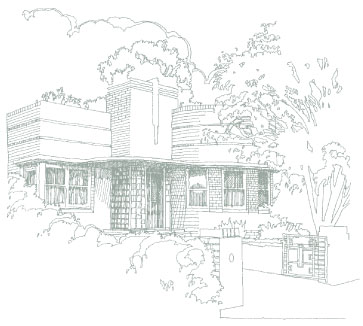
Alteration Principles Here are some general principles to keep in mind: > do as little as possible but as much as is necessary > ensure that you maintain key heritage features, and as much of the original fabric as is possible in its original location > where you must make a replacement, replace like with like if your house has wooden window frames, dont replace with aluminium > allow the heritage significance of your home to continue to be expressed in its physical form and materials Please seek further advice from an architect or builder before altering your home. |
Health & Safety Asbestos was widely used as a building material from 1919 until the early 1980s and exposure can cause permanent damage to your health. Do not allow anyone to start work on your renovation until you have established whether there is any present in the existing building. For information about asbestos, speak to your local council, architect or Registered Building Practitioner. Lead paints were also commonly used up to the 1980s, and can be toxic and harmful. There are many products and techniques to prepare finishes; ask your hardware supplier about the safest methods for your home. Always use a Registered Building Practitioner if your renovation project is valued at $5000 or more. Planning laws apply throughout Victoria and you may have to apply for a permit for more information, contact your local council. |
|
Paint Schemes We suggest that you refer to the appropriate code numbers when buying paints for your heritage paint scheme. |
| Name | AS 2700 | Housing Styles |
| Biscuit | X42 | EV, LV, ED |
| Black | N61 | MD |
| Brown | X54 | EV, LV |
| Buff | X41 | ED, BG |
| Canary Yellow | Y11 | PW |
| Cream | Y34 | BG, MD |
| Dark Brown | X65 | QA, BG, IW |
| Dark Earth | X62 | EV |
| Dark Green | G61 | BG |
| Deep Indian Red | R64 | EV, MV, LV, BG, IW |
| Fern Green | G24 | IW, MD |
| Golden Tan | X53 | PW |
| Manilla | Y45 | FD |
| Off White | Y35 | IW, PW |
| Pale Blue | B35 | PW |
| Pale Ochre | X21 | IW, MD |
| Parchment | X43 | PW |
| Red Oxide | R63 | FD, ED |
| Rose Pink | R25 | IW, PW |
| Royal Blue | B12 | PW |
| Salmon Pink | R42 | MV, LV, MD |
| Signal Red | R13 | PW, MD |
| Terracotta | R52 | EV, IW |
| Venetian Red | R62 | MV, ED |
| White | N14 | BG, IW, MD |
| Name | BS 3881 or 2660 | Housing Styles |
| Brilliant Green | 381:221 | FD |
| Deep Brunswick Green | 381:227 | EV, MV, LV |
| Fawn | 2660:3035 | MV |
| Light Buff | 381:358 | MV |
| Light Cream | 2660:3033 | EV, LV FD, MD |
| Light Stone | 381:361 | EV, MV, LV, BG |
| Light Straw | 381:384 | LV, FD, ED |
| Mid Brunswick Green | 381:226 | ED |
| Olive Green | 381:220 | FD |
| Pale Cream | 381:352 | FD, ED |
| Pale Green | 2660:6070 | FD, ED, BG |
| Pink Beige | 2660:3034 | MV |
EV Early Victorian MV Mid Victorian LV Late Victorian FD Federation ED Edwardian
BG Bungalow IW Inter-war PW Post-war MD Modern
Further Information: For direction and ideas about building and renovating, please visit the following websites: www.buildingcommission.com.au www.archicentre.com.au www.consumer.vic.gov.au If your home is registered by the Heritage Council and you are considering renovation, see our Information Leaflet: For anyone with an older home, see our Technical Information series, for practical information about restoration and conservation of older houses. Please go to the Links and Resources tab at the bottom of this page for a more complete list of resources. |
